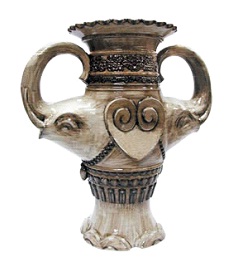LOM – Laminated Object Manufacturing is a lesser known 3D printing technology. Its hallmark is the ability to produce large parts cheaply – LOM 3D printers can use adhesive-laminated paper sheets as raw material. However, it also has other pluses, as well as certain disadvantages, stemming both from the technological process and materials used.
The LOM 3D Printing Process, Step by Step:
- A sheet of laminated material is unwound from a feed roll onto the platform or substrate.
- A heated roller then melts the laminate, affixing this sheet of material to the substrate.
- A laser or knife is used to trace out the layer’s outline.
- The laser or knife then cuts a border around the build containing the desired part and cross-hatches non-part areas so removing waste material is easier. The extra material is then wound up on a take-up roll.
- The platform with completed layers moves down, and fresh material is rolled over it.
- The whole process is repeated.
- When the build is completed, the platform and the part are removed from the machine.
- The part is removed from the platform.
- Finally, the frame and supports are removed from the part.
This last step – removal of frame and supports – can vary in difficulty. It chiefly depends on the design of the part. Sometimes just shaking the part is enough, and sometimes it has to be chiseled manually.
Additionally, since LOM uses paper as its basic raw material (though attempts to use other materials such as plastics and even ceramics and metals are being made), the part usually has to be sanded down and lacquered to achieve the final finish. If the part isn’t sealed with paint or lacquer, it can suffer from moisture penetration. Before the part is sealed, though, it has the characteristics of a wooden piece, and can be worked like one.
Laminated object manufacturing is an inexpensive process that outputs a piece that looks like its made of wood, behaves like its made of wood, and can be worked like its made of wood. However, if not sealed or otherwise protected, your part can get deformed.
Dimensionally, LOM-produced parts suffer a little in accuracy when compared to other 3D printing technologies like SLA, FDM or SLS. LOM-printed parts also have a fairly rough surface finish – one consequence of their wood-like structure – and the whole layer-on-layer-of-paper thing makes stairstepping on edges very pronounced. Oh, and a lot of raw material may get scrapped during the printing process, depending on your design.
On the plus side, LOM is very cheap, quite fast – build time doesn’t significantly increase with part size – and is a successful niche 3D printing technology. It’s a popular choice for certain items like ceramic parts, biomedical and fluidic instrumentation and components, or stamping dies, but isn’t really a good general solution.


From the material recycling perspective, could aluminum foil like chocolate wrap be used as any source for feed?
Thanks.
I don’t know of any printer using aluminum foil, but things are advancing quickly! The melt point of aluminum is lower than most metals, so maybe it’s just a matter of time.